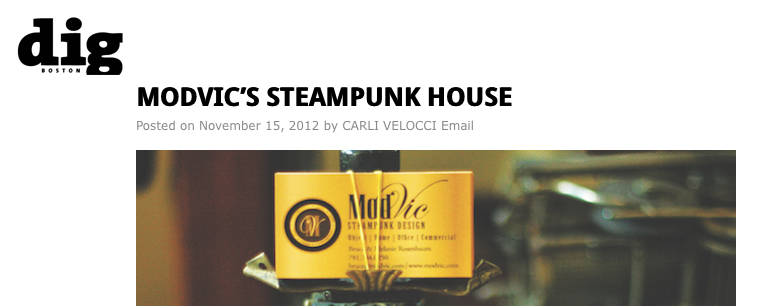
Despite the common misconception, steampunk is not just about gears, monocles, and top hats. Although, I guess that could be considered a small part of it. A decent part of it, we’ll say.
But, according to Bruce Rosenbaum, founder of ModVic, an interior decorating company with a steampunk twist, the aesthetic means so much more.
It’s a combination of opposites into something that is both modern and nostalgic, functional yet artistic, old yet new.
As he puts it: “It’s the fusion of modern technologies, conveniences, and needs into period objects—having the best of two worlds.” He says this standing in the library of his century-old home in Sharon, dubbed the “steampunk house” by admirers of its nearly top-to-bottom Victorian indulgence. The walls are outfitted with old family photographs and bizarre decorative pieces that create a timeline of American aesthetics. The computer in his office is set against a pipe organ, with a typewriter in place of a typical keyboard and a webcam nestled inside of an accordion lens. Rosenbaum’s house makes sure to emphasize that all of these pieces have a story, and part of what he does is about the “hunt” for that story.
“Victorians were well known for curiosity,” he explains. “You go into somebody’s home, and you ask ‘What is that?’ and there will be a story.
Steampunk sets you up to ask the questions of, ‘What is this thing? Where did it come from? How did you do this?’”
These questions are asked over and over again as you walk through his house. When you walk into the family room and see his television—which has been built into a fireplace mantle—you have to ask him how he did it. When you see the computers in the library, you have to wonder how he thought to use old optometrist equipment to support the monitors. He has a bit of a fascination with the industry, and even uses similar pieces as decorative vases for his flowers.
The home looks relatively nondescript considering its name, but that’s only until you get to his office, which has been transformed into a cabin’s quarters on a ship complete with navigational devices and other nautical touches. You have to ask him how he managed all of it, but it seems almost impossible to tell since everything in that room has its own history, even the small decorative pieces in the corners.
Everything here is authentic; items he discovered at antique shows.
The punch card machine in his office—which was the precursor to the modern computer—real. The 1930s toaster in his kitchen is functional, and also real.
“We find objects that no longer have purpose or relevance. These objects that were so well thought of no longer have purpose. They either become museum pieces or get tossed.
We are now finding these objects and giving them new life, finding new ways in which they can become relevant again.”
His workshop is an example of this: a space of organized chaos, cluttered tables, and old newspapers. This is a place that is so full of antiques he could probably open his own art show in his basement. There would definitely be enough interest. His business is booming, and his voice has become sought after for seminars and lectures on steampunk’s growing mainstream popularity.
“People are starting to get bored of what’s around them,” explains Rosenbaum. “Also, because of the economy, there’s this feeling that ‘let’s get back to something real … Go back to something authentic, let’s get back to our roots.’
“There are enough people that are aware about steampunk and what we are doing, and think it’s so good, and want to bring it into their homes or offices or businesses, that I’m just now starting to feel that this could be a real business, and a real design aesthetic.”
